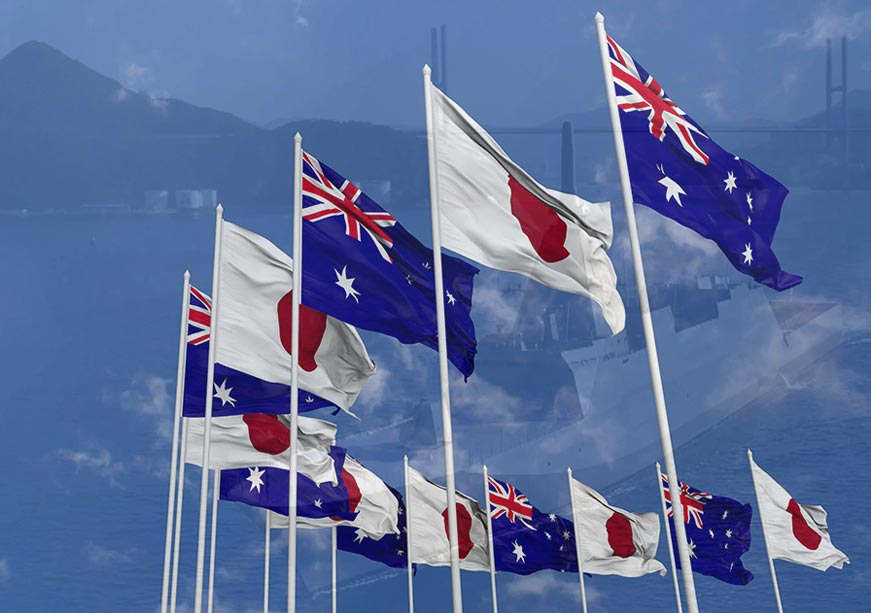-
CENTRES
Progammes & Centres
Location
The Japan–Australia frigate deal marks a strategic milestone—boosting Australia’s naval power while signalling Japan’s shift from post-war pacifism to proactive security engagement

On 5 August 2025, Australia and Japan announced a landmark US$6.5 billion agreement for the supply of upgraded Mogami-class multi-role frigates from Japan to the Royal Australian Navy. The first three vessels will be constructed in Japan, with Mitsubishi Heavy Industries (MHI) as the prime contractor starting from 2029, with the remaining eight being slated for local assembly at Henderson, Western Australia. The deal, a strategic force multiplier, marks Tokyo’s most significant defence export since lifting its defence sales ban in 2014, underscoring another step in its shift away from post-war pacifism toward a more proactive role in a tenuous Indo-Pacific.
The new vessels will significantly enhance the Australian Navy’s ability to project power across its northern approaches and safeguard vital sea lanes in both the Indian and Pacific Oceans. The Mogami frigates will replace Australia’s ageing Anzac-class fleet and enter service from 2029–2030, with full operational capability expected by around 2030. These ships feature 32 vertical launch cells (up from the Anzac's 16), a range of up to 10,000 nautical miles, and a highly automated design requiring a crew of just 90 personnel. With quadruple the missile capacity of current frigates and extended operational range, they represent a marked leap in lethality, autonomy, and overall maritime combat capability.
The deal, a strategic force multiplier, marks Tokyo’s most significant defence export since lifting its defence sales ban in 2014, underscoring another step in its shift away from post-war pacifism toward a more proactive role in a tenuous Indo-Pacific.
The deal also carries domestic benefits for Canberra, with local assembly of the frigates projected to generate around 10,000 high-skilled defence jobs over two decades. This reinforces the Albanese government’s commitment to allocate US$ 37.8 billion to bolster the navy’s fleet of surface combatants. The frigates will also fill a critical capability gap before the delayed Hunter-class frigates enter service, in turn ensuring fleet readiness during the transition. Strategically, the deal deepens alignment with the United States (US) and Japanese defence architectures, fostering interoperability and joint operational readiness among key Indo-Pacific allies.
Japan’s post-war defence restrictions were rooted in Article 9 of the 1947 Constitution, which renounced war as a sovereign right and prohibited the maintenance of “land, sea, and air forces, as well as other war potential.” Successive governments have interpreted this clause as permitting the existence of the Self-Defence Forces (SDF) for strictly defensive purposes, with Tokyo maintaining stringent limits on the scope of its activities. Among these constraints was a near-total ban on arms exports, formalised in 1967 under former Prime Minister Eisaku Satō’s Three Principles on Arms Exports and expanded in 1976 to prohibit sales to all countries except under narrow humanitarian or technology-sharing arrangements with the US. This effectively shut Japan out of the global defence trade and constrained the SDF’s participation in international missions, keeping its posture firmly within the boundaries of post-war pacifism.
The shift came in April 2014, when Prime Minister Shinzo Abe’s government replaced the old framework with the Three Principles on Transfer of Defence Equipment and Technology. This new policy allowed Japan to export arms and related technology under certain conditions, which include contributing to international peace and security, bolstering security cooperation with partner nations, and ensuring strict controls to prevent retransfer to third parties. The reform aimed to strengthen Japan’s defence-industrial base, enhance interoperability with allies, and allow it to play a more proactive security role in response to a deteriorating regional environment, particularly the rise of Chinese military power and North Korean missile threats. While the 2014 policy retained specific safeguards on exports to nations with which Japan has security cooperation agreements, it marked a decisive break from the blanket prohibitions of the previous decades, paving the way for landmark deals such as the 2025 sale of frigates to Australia.
The deal represents a historic moment for Japan, its largest arms export since lifting post-war restrictions, marking an important shift in its defence-industrial position
The deal represents a historic moment for Japan, its largest arms export since lifting post-war restrictions, marking an important shift in its defence-industrial position and signalling its emergence as a supplier of advanced defence equipment. The agreement deepens Tokyo’s security engagement beyond its US alliance, cementing a closer strategic partnership with Australia at a time of shifting regional power balances. Moreover, by entrusting MHI with overseas delivery and partial production in Australia, Japan is testing its capacity to scale up defence exports, overcome logistical and workforce challenges, and enhance its standing in the global arms market.
In the broader Indo-Pacific context, the deal reinforces a networked deterrence architecture, complementing frameworks like AUKUS, a trilateral security pact between Australia, the UK, and the US; the SQUAD, a minilateral alliance of the U.S., Japan, Australia, and the Philippines; the Quad, a grouping of Australia, India, Japan, and the US, to tighten trilateral security coordination. As China’s naval assertions repeatedly test the boundaries of maritime law, Canberra’s strengthened naval capabilities, together with Tokyo’s re-entry into the arms export arena, signal a recalibration of deterrence in the Indo-Pacific. The split production model points to deeper industrial integration between the two countries, with potential spillovers in supply chain cooperation—or competition—among other regional shipbuilding powers. Symbolically, the sale is a clear message of Japan’s willingness to assume a more hands-on regional security role alongside ‘like-minded’ nations.
In the broader Indo-Pacific context, the deal reinforces a networked deterrence architecture, complementing frameworks like AUKUS.
For Australia, it accelerates the modernisation of its fleets, ramps up maritime reach, and supports domestic industrial growth. Whereas for Japan, it symbolises a tangible shift from pacifist restraint to proactive defence diplomacy and industrial engagement. For the Indo-Pacific, it signals an evolving security ecosystem where interoperability, coordinated naval power, and strategic management forge a more resilient landscape in the face of revisionist forces.
Pratnashree Basu is an Associate Fellow at the Observer Research Foundation.
The views expressed above belong to the author(s). ORF research and analyses now available on Telegram! Click here to access our curated content — blogs, longforms and interviews.

Pratnashree Basu is an Associate Fellow with the Strategic Studies Programme. She covers the Indo-Pacific region, with a focus on Japan’s role in the region. ...
Read More +